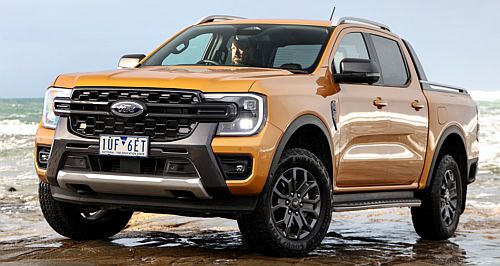News - Market Insight - Market Insight 2023Market Insight: Supply issues hit utesCyclical: Sales of 4x4 utes are up 5.9 per cent but fleet-sensitive 4x2 volume has slipped on buying cycles. Ford comes out on top as ute sales figures skewed by supply, quarantine bottlenecks27 Feb 2023 By NEIL DOWLING AUSTRALIANS bought 228,671 utes in 2022, representing 22 per cent of the total new car market as new models and fresh upgrades became the catalyst for increased buyer demand.
Despite headwinds in supply and logistics, there were 28 ute models from 14 brands available in Australia last year.
Surprisingly, despite the increased frequency of ute sightings on the nation’s roads, this statistic does not represent a lot of change from a decade ago when buyers had their pick of 29 models from 12 brands.
New players over the past five years are predominantly Chinese – LDV and GWM – with contributions from South Koea’s SsangYong and the two major US brands Chevrolet and Ram.
Added to that are remanufactured utes that include the Toyota Tundra and Ford F-Trucks, neither of which are listed in VFACTS delivery data.
Sales of the main players in Australia’s 4x2 and 4x4 ute segments have retained much of their market share over the past decade, with production and supply chain issues eroding gains across the board in 2021 and 2022.
In addition, shipping holdups at Australian ports, triggered by more intense contamination and quarantine procedures by authorities, have squeezed delivery to ports and then to dealerships and ultimately, customers.
There has also been some unusual sales activity in some months that can also be attributed to the arrival of ships.
If one brand gets two shipments in one month, for example, it is reflected in a strong sales period while a brand that had delayed shipments would report fewer sales, indicating a lack of demand.
While all brands are affected by the various problems, on paper at least these issues hit Nissan and Mitsubishi particularly hard.
Sales of Mitsubishi Triton 4x4 variants were down a big 59.6 per cent in the first month of this year compared with January 2022, while Nissan Navara 4x4 sales have fared a fraction worse with a 59.8 per cent plunge.
A Nissan spokesperson told GoAuto that Navara order books remained strong. Buyers have had a wait of up to six months but now stock flow is improving and delivery times are being reduced.
Delays have made a huge dent in Nissan’s performance. Navara 4x4 sales were only 410 units in January, down 59.8 per cent, while the 4x2 models found only 19 buyers, down 88.1 per cent.
From these figures it is easy to surmise that there is weak demand for 4x2 models, although such products are predominantly fleet territory and aside from production holdups, these variants are subject to buying programs from fleet organisations.
Mitsubishi was similarly affected and for the same reasons. The Triton 4x4 had 1051 buyers in January, down 59.6 per cent on the same month in 2022, while the 4x2 variant had 202 sales, down 25.7 per cent.
By contrast, Toyota HiLux sales were up 18.5 per cent in January with 3044 deliveries for the 4x4 while the 4x2 version had a 6.4 per cent increase to 1087 sales.
The Ford Ranger did even better, 4x4 variants amassing 4250 sales in the first month of 2023 – up 42.3 per cent – and the 4x2 model had 499 buyers that represented a 92.7 per cent increase.
Ford Australia spokesperson Ben Nightingale said delays were mainly caused by the shortage of semiconductors, affecting the higher-spec, private-market targeted 4x4 models.
He added that Ford, like its rivals, was subjected to the shipping delays and port bottlenecks that constricted supply to dealers.
Mr Nightingale explained that Ford was fortunate to have stocks of the previous-generation Ranger still available to buyers, which maintained high sales for dealers in the transition to the new model.
Isuzu Ute sales are also strong, with the D-Max 4x4 up 12.6 per cent (1637 sales in January) while the 4x2 sales went backwards by 53.3 per cent to 206 units, partially on fleet buying programs but also on production.
Isuzu Ute Australia director of sales Koichiro Yoshida told GoAuto that reduced sales numbers for D-Max 4x2 models year-to-date compared to 2022 was “a direct reflection of what models are being produced at any one time and is not a reflection on demand”.
“We would expect this to balance out through the year,” he said.
“There is no real influence on the delivery numbers for 4x2 D-Max models, the result is based on what we’ve received at the time for delivery and based on what was produced a few months earlier.”
Mazda’s BT-50, built by Isuzu and heavily based on the D-Max, had similarlystrong 4x4 sales (1169 for January, up 11.7 per cent) while 4x2 sales were down on the previous January by 13.7 per cent to 151 units for the month.
GWM, which markets its ute as the Cannon, had an excellent January with solid demand and a 212.7 per cent increase in the month’s sales compared with the previous year, finding 716 buyers for the 4x4.
In line with the cyclical 4x2 market, GWM also sold only 10 units of this drivetrain layout in January, down 68.8 per cent on 2022.
Improved sales were also seen by Volkswagen with its Amarok – now only available as a 4x4 – up 18.8 per cent with 291 sales; and SsangYong’s Musso (again, only 4x4) up 121.6 per cent finding 308 buyers.  |
Click to shareMarket Insight articlesResearch Market Insight Motor industry news |
















Facebook Twitter Instagram